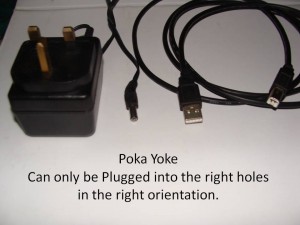What is Poka Yoke
Poka Yoke or Mistake proofing is a simple technique that developed out of the Toyota Production system through Jidoka and Autonomation. It is normally a simple and often inexpensive device that prevents defects from being made or highlights a defect so that it is not passed to the next operation.
This article will run through;
- The development and history of Poka Yoke
- Why we need it
- The effectiveness of Inspection
- The different types of Pokayoke
- Examples of Poka Yoke
The Development of Poka Yoke
Pokayoke was developed and classified by Shigeo Shingo who wrote the definitive works on this technique, although he is not the one who invented the idea. The idea of mistake proofing has been around for a long time before it was identified as a specific lean tool. The humble three pin plug for instance had several designs created in the early part of the 20th century long before anyone heard of poka yoke.
Originally many people called the technique fool-proofing, however this was clearly derogatory towards the people using the device; after all even the best of us can make a mistake.
Mistakes vs Defects
He differentiates between mistakes which in most cases are inevitable and defects which are mistakes that manage to get through the system and reach the customer. Poka Yoke seeks to prevent mistakes from becoming defects.
Quality Control vs PokaYoke
Shigeo Shingo saw quality control as a three level hierarchy of effectiveness;
- Judgement Inspection – Inspectors Inspect
- Informative Inspection – Use of SPC to monitor the process conditions
- Before the fact – Poka Yoke
The least effective form of quality control being the use of inspection and the most effective being the use of autonomation and PokaYoke devices to prevent or highlight defects without any form of judgement or relying on the operator to do something.
The effectiveness of 100% inspection
The least effective form of quality control is that of inspection by people, people are fallible and can often fail to observe problems especially if the work is repetitive and the shift is long. However that does not mean that operator inspection should be dismissed as being of no value, having each and every operator inspect the work that they receive before use and the work that they produce is still an effective way to reduce the possibility of defects reaching the customer, although it is not the best.
Take this small test that was developed by the American society for quality to demonstrate how effective 100% inspection can be. Read the following paragraph and while you do so count the number of times the letter “f” occurs;
The answer is at the bottom of the page, however most people will not get the right answer; their answers will vary between about 30 and 60 letter “f”s in the paragraph having missed letters or double counted.
Inspection still has its place
However as I said do not discount inspection as ineffective, consider a process in which inspection is 90% effective for each operator. If 1000 defects are passed by the first operator he will miss 100, but of these 100, the next operator will only miss 10 and the third just 1 at 90% per operator so a number of linked processes with each operator inspecting the quality of work arriving can still be effective at removing defects; although not the best and most reliable.
Purpose of Poka Yoke
We overcome the inefficiencies of inspection through the use of automatic devices called Poka Yoke, these seek to do three things;
- Not accept a defect for the process
- Not Create a Defect
- Not Allow a Defect to be passed to the next process
They do this in a number of different ways but can be categorized as being either;
- Control – they take physical action to prevent a defect
- Warning – They sound an alarm or light up to tell us a mistake has been made.
An example or a control type Poka Yoke is one that physically rejects an underweight product on a conveyor whilst a warning Pokayoke is one that sounds an alarm such as the one that sounds when you accidentally leave your lights on in the car when you remove the ignition key.
They can then be further classified into the following three types;
- Contact
- Fixed Value
- Motion Stop
Poka Yoke Examples;
Contact Poka Yoke
Contact type Poka Yoke devices that have physical shapes that are used to prevent the use of incorrect components, pins that have to fit into holes from previous operations and so on, they physically make contact with the product and highlight when a mistake has been made or physically make it impossible to make the mistake. A three pin plug would fit into this category as it can only be plugged into a socket in one orientation and the sim card in your phone can only be fitted one way around in your phone.
Fixed Value Poka Yoke
Fixed Value Pokayoke is a method that uses physical and visual methods to highlight that all components are available in the right quantities and have been used, sometimes combined with contact style sensors to make them more positive. Examples would be egg tray style containers that present the operator with exactly the right number of fixings or pre-dosed medication in a sachet rather than relying on the user to measure from a larger container.
Motion Stop pokayoke
Pokayoke Device Video
These types of Pokayoke devices ensure that the correct number of steps have been taken and possibly also the sequence of steps, examples of this could be the use of a nut runner to tighten a specific number of bolts to a required torque; if the correct torque is not reached or if the operator does not tighten all of the bolts the part will not be released to the next operation. The video above provides a good example of a motion stop pokayoke device.
Additional Poka Yoke Resources
There is a good article about Poka Yoke here on the Harvard Business Review as well as an article here about using Poka Yoke for software.
Poka Yoke Reference Books;
Zero Quality Control: Source Inspection and the Poka-Yoke System The definative work by Shigeo Shingo, required reading.
Mistake-Proofing for Operators Learning Package: Mistake-Proofing for Operators: The ZQC System (Shopfloor Series) Simple and useful book aimed at your employees.
Poka Yoke Video
The Cost of Poka Yoke
Whatever type of Poka Yoke device you use you should ensure that it is inexpensive and simple, there are often simple effective solutions that can be designed without the need to spend vast sums; if huge amounts of money are being considered then you have not thought deeply enough about the problems.But you should also consider the cost of the defect itself; how much will a defect reaching the customer cost you?
Poka Yoke is one of the most effective ways to prevent defects reaching your customers and should be used in any lean manufacturing or Total productive maintenance (TPM) implementation (and there are 48 f’s in the text example above.)




I’m Santosh Shetty, I want to implement the Poka yoka system into the machine itself?? What I meant is the interface that need to be involved. I’m now currently working at an automobile company and I have to find the way on how to implement the pokayoka system into our production machine. Your reply will help us or else you will support by your equipments and tools.